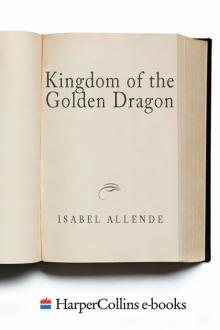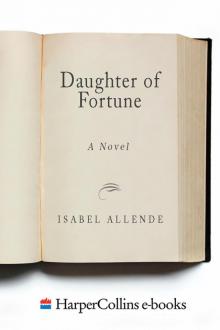- Home
- Isabel Allende
Kingdom of the Golden Dragon
Kingdom of the Golden Dragon Read online
Dedication
For my friend Tabra Tunoa, tireless traveler,
who took me to the Himalayas and told me about
the Golden Dragon.
Contents
Dedication
CHAPTER ONE
The Land of Snow and Ice
CHAPTER TWO
The Valley of the Yetis
CHAPTER THREE
Three Fabulous Eggs
CHAPTER FOUR
The Collector
CHAPTER FIVE
Eagle and Jaguar
CHAPTER SIX
Cobras
CHAPTER SEVEN
The Sect of the Scorpion
CHAPTER EIGHT
In the Forbidden Kingdom
CHAPTER NINE
Kidnapped
CHAPTER TEN
Borobá
CHAPTER ELEVEN
The White Eagle
CHAPTER TWELVE
The Totemic Jaguar
CHAPTER THIRTEEN
Medicine for the Mind
CHAPTER FOURTEEN
The Golden Dragon
CHAPTER FIFTEEN
The Cave of the Bandits
CHAPTER SIXTEEN
The Cliff
CHAPTER SEVENTEEN
The Yeti Warriors
CHAPTER EIGHTEEN
The Fortified Monastery
CHAPTER NINETEEN
The Battle
CHAPTER TWENTY
The Prince
P.S. Insights, Interviews & More . . .
About the author
About the book
Read on
Also by Isabel Allende
Copyright
About the Publisher
CHAPTER ONE
The Land of Snow and Ice
THE BUDDHIST MONK NAMED Tensing and his disciple, Prince Dil Bahadur, had been climbing in the high peaks north of the Himalayas for many days, a region of eternal ice where no one but a few lamas had ever ventured. Neither of the two was counting the hours, because time did not interest them. The calendar is a human invention; time does not exist on the spiritual level, the master had taught his student.
For them it was the crossing that was important; the prince was making it for the first time. The monk remembered having done it in a previous life, but those memories were rather blurred. They were following the markings on an ancient parchment, orienting themselves by the stars in a terrain where even in summer conditions were very harsh. The temperature of several degrees below zero was endurable only two months during the year, when ominous storms were not lashing the mountains.
Even beneath the sunny, cloudless skies, the cold was intense. They were wearing rough wool tunics, and cloaks made from yak hide. Leather boots from the same animal covered their feet, with the long hair turned in and the outside weather-proofed with yak butter. The travelers placed each foot with care; one misstep on the ice and they could tumble hundreds of yards into the deep chasms that sliced through the mountains as if cleft by God’s hatchet.
Luminous snowy peaks stood out against a sky of deep blue. The travelers moved at a slow pace, because at those heights there was very little oxygen. They rested frequently, so their lungs would become accustomed to the altitude. Their chests ached, as did their ears and their heads. They were suffering from nausea and fatigue, but neither of the two mentioned such bodily weakness, saving their breath in order to get the maximum benefit from each mouthful of air.
They were searching for rare plants found only in the Valley of the Yetis, plants essential in preparing medicinal lotions and balms. If they survived the dangers of this journey, they would consider themselves initiated, for their characters would be tempered like steel. Their will and courage would be put to the test many times during that climb. The disciple would need both will and courage to carry out the task that awaited him in life, which was why he had been given the name Dil Bahadur, “brave heart” in the language of the Forbidden Kingdom. The pilgrimage to the Valley of the Yetis was one of the last steps in the harsh training the prince had been undergoing for twelve years.
The youth did not know the true reason for their trek, which was much more important than the gathering of curative plants or his initiation as a lama, or superior being. His master could not reveal it to him, just as he could not speak to him of many other things. Tensing’s role was to guide the prince during each stage of his long apprenticeship; he was charged with strengthening the young man’s body and his character and cultivating his mind, testing the quality of his spirit again and again. Dil Bahadur would discover the reason for the journey to the Valley of the Yetis later, when he found himself before the fabled statue of the Golden Dragon.
On their backs, Tensing and Dil Bahadur were carrying bundles that contained the blankets, grain, and yak butter they would need to survive. Rolled around their waists were coils of yak-hair rope, which they used in climbing, and in one hand each grasped a long, strong walking staff, which they used for support, for defending themselves in case of attack, and for setting up their improvised tent at night. In places where experience had taught them that fresh snow often covered deep openings, they also used their staffs to test the depth and firmness of a surface before stepping onto it. Frequently they were forced to make long detours around fissures that couldn’t be jumped over. Sometimes, to avoid going out of their way for hours, they laid one of the staffs across the crevasse, and only when they were sure it was firmly seated on either side did they dare step onto it and then leap to the other side—never more than one step, because the risk of plummeting into empty space was too big. They made such leaps without thinking, with their minds clear, trusting in physical skill, instinct, and luck, because if they stopped to weigh each move it would be impossible to make it. When the opening was wider than the length of the staff, they looped a rope around an overhanging rock, then one of them tied the other end of the rope around his waist, took a running start, and leaped, swinging back and forth like a pendulum until he reached the other side. The young disciple, who had great stamina and courage in the face of danger, always hesitated at the moment they were forced to use those methods.
The pair had come to such a chasm, and the lama was looking for the best place to cross. The youth briefly closed his eyes, sending a prayer skyward.
“Do you fear dying, Dil Bahadur?” Tensing inquired, smiling.
“No, honorable master. The moment of my death was written in my fate before my birth. I shall die when my work is finished in this reincarnation and my spirit is ready to fly, but I do fear breaking all my bones down there, and living,” the youth replied, pointing to the impressive precipice yawning at their feet.
“That could, perhaps, present a problem,” the lama conceded with good humor. “If you open your mind and heart, it will seem easier,” he added.
“What would you do if I were to fall?”
“Should that occur, I would possibly have to think about it. For the moment, my thoughts are turned to other things.”
“May I know what, master?”
“The beauty of the panorama,” the lama replied, indicating the endless chain of mountains, the immaculate white of the snow, the brilliant sky.
“It is like the landscape of the moon,” the youth observed.
“Possibly . . . What part of the moon have you visited, Dil Bahadur?” the lama asked, hiding another smile.
“I have not traveled that far as yet, master, but I imagine it like this.”
“On the moon, the sky is black and there are no mountains like these. There is no snow, either; everything is rock and ash-colored dust.”
“Perhaps some day I shall be able to make an astral voyage to the moon, like my
honorable master,” the disciple conceded.
“Perhaps . . .”
After the lama positioned his staff, both took off their tunics and cloaks, which kept them from moving freely, and made four bundles of their belongings. The lama was built like an athlete. His shoulders and arms were pure muscle, his neck was as broad as a normal man’s thigh, and his legs as thick as tree trunks. That formidable warrior’s body contrasted markedly with his serene face, gentle eyes, and delicate—almost feminine—and always-smiling mouth. Tensing took the bundles one by one, built up momentum by rotating his arm like the vanes of a windmill, and tossed the bundles to the other side of the chasm.
“The fear is not real, Dil Bahadur; it is only in your mind, like all other things. Our thoughts form what we believe to be reality,” he said.
“At this moment, my mind is creating a very deep crevasse, master,” the prince murmured.
“And my mind is creating a very strong bridge,” the lama replied.
He waved to the youth, who stood waiting in the snow, then took one step above the void, planting his right foot at the middle of the wood staff and a fraction of a second later throwing himself forward, reaching the other side with his left foot. Dil Bahadur imitated him with less grace and speed, but gave no sign of nervousness. The master noticed that his student’s skin was gleaming with sweat. They quickly dressed and resumed walking.
“Is it much farther?” Dil Bahadur wanted to know.
“Possibly.”
“Would it be imprudent, master, to request that you not always answer ‘possibly’?”
“Perhaps it would.” Tensing smiled, and after a pause added that, according to the instructions on the parchment, they were to continue north. The most difficult portion of their path lay ahead.
“Have you seen the Yetis, master?”
“They are like dragons, they shoot fire from their ears and they have four pairs of arms.”
“Amazing!” the youth exclaimed.
“How many times have I told you not to believe everything you hear? Seek truth for yourself,” the lama laughed.
“Master, we are not studying the teachings of Buddha, we are simply talking.” The disciple sighed, annoyed.
“I have not seen the Yetis in this life, but I remember them from a previous one. We share common ancestors, and several thousand years ago they had a civilization almost as developed as our own, but now they are very primitive and of limited intelligence.”
“What happened?”
“They are very aggressive. They killed each other and destroyed everything they had, including the land. The survivors fled to the peaks of the Himalayas and there their race began to decline. Now they are like animals,” the lama explained.
“Are there many of them?”
“Everything is relative. They will seem to be many if they attack us and few if they are friendly. In any case, they do not live very long lives but they reproduce easily; therefore I suppose there will be a number of them in the valley. They live in an inaccessible region where no one can find them, but sometimes one of them ventures out in search of food and gets lost. That is possibly the source of the tracks attributed to the Abominable Snowman, as he is called,” the lama put forward.
“Their footprints are enormous. They must be giants. Will they still be very aggressive?”
“You ask many questions for which there are no answers, Dil Bahadur,” the master replied.
Tensing led his disciple through the mountain peaks, leaping chasms, scaling vertical faces, slipping along narrow paths cut into the rock. Occasionally they came across old hanging bridges, but they were in very poor condition and could be used only with great care. When there was wind or sleet, they looked for shelter and waited. Once a day they ate their tsampa, a mixture of toasted barley flour, dried herbs, yak butter, and salt. They found abundant water beneath the crust of ice. Young Dil Bahadur often had the impression that they were walking in circles, because the landscape looked the same, but he said nothing about his doubts: it would be discourteous to his master.
As evening fell, they looked for a sheltered place to spend the night. Sometimes it was nothing but a rift in which they could find comfort protected from the wind, other nights they might find a cave, but occasionally they had no choice but to sleep out in the open, barely shielded by their yak cloaks. Once they set up their austere camp, they sat facing the setting sun, legs crossed, and chanted the essential mantra of Buddha, repeating over and over Om mani padme hum—Hail, precious jewel in the heart of the lotus. The echo would repeat their prayer, multiplying it to infinity among the high peaks of the Himalayas.
During the day’s march they gathered sticks and dried grasses, which they carried in their pouches for building the nightly fire and for cooking their food. After the evening meal, they meditated for an hour. During that time the cold left them stiff as ice statues, but they scarcely felt it. They were used to such immobility, which brought them calm and peace. In their Buddhist practices, master and student sat in absolute relaxation, but remained alert. They rid themselves of all the distractions and worries of the world, though they never forgot the suffering that existed everywhere.
After scaling mountains for several days and climbing the frozen heights, they came to Chenthan Dzong, the fortified monastery of the ancient lamas who had invented the form of hand-to-hand combat called Tao-shu. In the nineteenth century, the monastery had been destroyed by an earthquake and had to be abandoned. It was built of stone, brick, and wood, with more than a hundred rooms that seemed glued to the edge of an impressive cliff. For centuries the monastery had housed monks whose lives were dedicated to spiritual quest and to perfecting the martial arts.
The Tao-shu monks had originally been physicians with an exceptional knowledge of anatomy. In their practice they had identified vulnerable points of the body that were numbed or paralyzed when pressed, and they combined that knowledge with techniques of wrestling known in Asia. Their objective was to reach spiritual perfection through control of their own strength and emotions. Although they were invincible in hand-to-hand combat, they did not use the Tao-shu for violent ends, only as a physical and mental exercise. Similarly, they did not teach their art to just anyone, only to certain chosen men and women. Tensing had learned Tao-shu from those monks, and he had taught it to his disciple Dil Bahadur.
The earthquake, snow, ice, and the passage of time had eroded most of the building, but two wings were still standing, although they were in ruins. The travelers had reached the monastery by climbing a precipice so difficult and remote that no one had attempted it for more than half a century.
“Soon they will come to the monastery by air,” Tensing observed.
“Do you believe, master, that they will discover the Valley of the Yetis from airplanes?” the prince inquired.
“Possibly.”
“Imagine how much effort could have been saved. Before long we could have flown here.”
“I hope that it will not be so. If they trap the Yetis, they will turn them into circus animals, or slaves,” the lama said.
They went into Chenthan Dzong to rest and to spend the night in its shelter. Threadbare tapestries with religious images still hung on some of the walls, and they found cooking vessels and weapons the warrior monks who survived the earthquake had not been able to take with them. There were several representations of Buddha in varying postures, including an enormous statue of the Enlightened One lying prone on the ground. The gilt had cracked away, but the remainder of the statue was intact. Ice and blowing snow covered nearly everything, lending the ruins a particularly beautiful aspect, as if it were a crystal palace. Behind the building, an avalanche had created the only level surface in the area, a kind of courtyard about the size of a basketball court.
“Could an airplane land here, master?” asked Dil Bahadur, unable to disguise his fascination with the few modern apparatuses he knew.
“I know nothing of these things, Dil Bahadur. I have never s
een an airplane land, but it seems to me that this space is very small, and besides, the mountains act like a funnel, drawing strong air currents.”
In the kitchen they found pots and other iron implements, candles, charcoal, sticks for making a fire, and some grains preserved by the cold. There were also vessels for holding oil and a container of honey, which the prince had never seen. Tensing gave him a taste, and for the first time in his life the prince felt something sweet on his tongue. The surprise and the pleasure nearly knocked him off his feet. They built a fire for cooking and lighted candles before the statues, as a sign of respect. That night they would eat well and they would sleep beneath a roof: the occasion merited a special brief ceremony of thanks.
They were meditating in silence when they heard a low moan echoing through the ruins of the monastery. They opened their eyes just as a rare white tiger padded into the ruined room, a half-ton of muscle and white fur, the fiercest animal known to the world.
Telepathically, the prince received his master’s command, and tried to obey, although his instinctive reaction had been to call on Tao-shu and leap up to defend himself. If he could get close enough to reach behind the cat’s ears, he could paralyze it; he sat motionless, however, trying to breathe calmly so the beast would not pick up the scent of fear. The huge feline slowly advanced toward the monks. Despite the imminent danger in which he found himself, the prince could not help but admire the animal’s extraordinary beauty. Its fur was a pale ivory with dark markings, and its blue eyes were the color of some of the glaciers in the Himalayas. It was an adult male, enormous, powerful, a perfect specimen.
Sitting in the lotus position with legs crossed and hands upon their knees, Tensing and Dil Bahadur watched the tiger move toward them. They both knew that if it was hungry, there was little possibility of stopping it. Their hope was that the animal had eaten, although it was not very likely that game was abundant in these barren solitudes. Tensing possessed uncommon psychic powers because he was a tulku, the reincarnation of a High Lama of antiquity. He concentrated that power like a beam to penetrate the beast’s mind.

 The Stories of Eva Luna
The Stories of Eva Luna The House of the Spirits
The House of the Spirits Paula
Paula Ines of My Soul
Ines of My Soul Of Love and Shadows
Of Love and Shadows Kingdom of the Golden Dragon
Kingdom of the Golden Dragon Daughter of Fortune
Daughter of Fortune City of the Beasts
City of the Beasts Maya's Notebook
Maya's Notebook Eva Luna
Eva Luna Zorro
Zorro In the Midst of Winter
In the Midst of Winter Forest of the Pygmies
Forest of the Pygmies My Invented Country: A Nostalgic Journey Through Chile
My Invented Country: A Nostalgic Journey Through Chile The Japanese Lover
The Japanese Lover Portrait in Sepia
Portrait in Sepia Island Beneath the Sea
Island Beneath the Sea The Soul of a Woman
The Soul of a Woman A Long Petal of the Sea
A Long Petal of the Sea Ines of My Soul: A Novel
Ines of My Soul: A Novel The Sum of Our Days
The Sum of Our Days